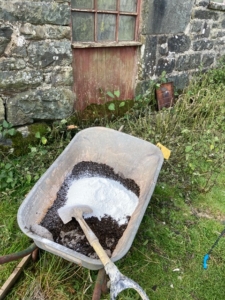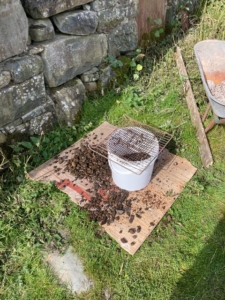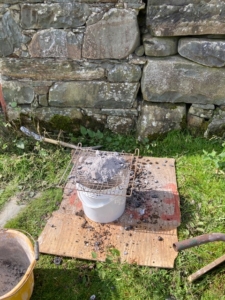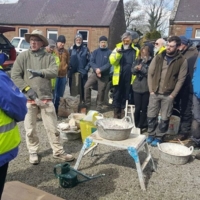This website uses cookies so that we can provide you with the best user experience possible. Cookie information is stored in your browser and performs functions such as recognising you when you return to our website and helping our team to understand which sections of the website you find most interesting and useful.
Wern Uchaf A Welsh Saga

Philip Scorer, Director Vitruvius Conservation, tells us about a recent lime mortar project in Wales.
At the head of a valley, surrounded by the rugged Rhinog mountains and natural beauty of Snowdonia national park sits a farmhouse built in 1886. Isolated from the world with only a footpath over boggy fields for access, no services except a stream fed by the the waters filtered through the sphagnum moss hillsides, this unspoilt, solidly built vernacular building has been looked after by volunteers since the last occupants left by 1960.
Over the decades some pragmatic but unsympathetic repairs have been carried out, often due to constraints of time and weather. Therefore it has fallen on myself and others to care for this very special gem.
An old colleague, his 3 teenage sons and myself visited recently to carry out some essential roof repairs and to deliver materials for future works. We arrived with a ton of sand, 5 bags of quick lime, 10 slate coping stones, tools, a large joint of beef and some essential cans of beer.
With the exception of the aforementioned repairs the great majority of the materials have survived the often spectacularly wet and windy weather and deep snows for over 100 years.
The walls are constructed of large pitched/squared stones of an impressive size. The Cambrian sandstone being chisel breaking hard. There is no sub soil to speak of being peaty and full of rocks so all the construction mortar and pointing are made of aggregate from the stream and lime.
Lime inclusions are evident every where and the coarse round aggregate is suspended in the lime rich mixture. Sheltered areas reveal a smooth flush finish with joint lines struck in to the surface but not a trace of exterior limewash or render is to be found even with the closest examination.
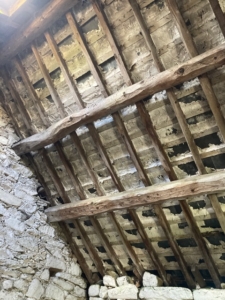
The underside of the Welsh slate roofs, house and surviving barn, have been ‘torched’ with a generous layer of haired lime plaster with no distinguishable aggregate. The interior walls and ceilings have been plastered with the same coarse aggregate for the base coat and skimmed with a mix similar to that used on the slates. Only where historic leaks have rotted the lath has the plaster really been lost.
Our job for the weekend was to lay 9m of missing slate copings on the roof gables before re-fitting boards to protect the exposed rafters.
In the past we have tried digging aggregates from the stream for mortar. However, but it was not possible to retrieve enough for our needs without seriously impacting the banks of the pristine water way and damaging the habitat of the few small trout that still inhabit it. So we brought down a ton of a local well graded sharp aggregate.
For the bedding of the copings we made a barrow mix of quick lime and the purchased aggregate. This was for two reasons. Firstly, the ingredients were similar to the original used and secondly if we need to re-roof in the future (highly likely) we would need to be able to remove the coping without destroying the slates underneath. The mix proved to be spreadable and sticky. This meant we were able to manipulate the 3ft slabs on the pliable mortar without breaking the underlying slates.
However, the bedding depth was significant, up to 1.5 inches due to the bowed roof. The thickness of pure lime mix would potentially suffer from frosts and heavy rain. So we used what we had to hand for the pointing.
We found enough exposed available gravel in the stream and sieved it through an old oven shelf and the ash was from the ground oven where we cooked our joint of beef.
Our winning mix consisted of two part purchased aggregate, one part sieved river gravel (<20mm) one calbux 90 quick lime and half wood ash mixed hot in a wheel barrow with a shovel.
This made an incredibly sticky gritty grey mortar that stiffened up in the barrow within hours of mixing. We pointed leaving the finish smooth as any ‘tending’ would pull out the larger aggregate making for a surface more vulnerable to saturation and frost damage. The weather was hot and dry (rare) and the pointing, an average of two inch deep and one inch wide was too hard to do anything with within a day.
We’ll see how it survives the winter but a similar mix we used about 20 years ago on the chimneys has survived unscathed.
Become a member
Members of the Building Limes Forum form a community of lime enthusiasts and practitioners, most of whom are producers, suppliers, specifiers or users of lime.
Useful documents
Contact Building Limes Forum
Building Limes Forum
Riddle’s Court
322 Lawnmarket
Edinburgh, EH1 2PG, UK

